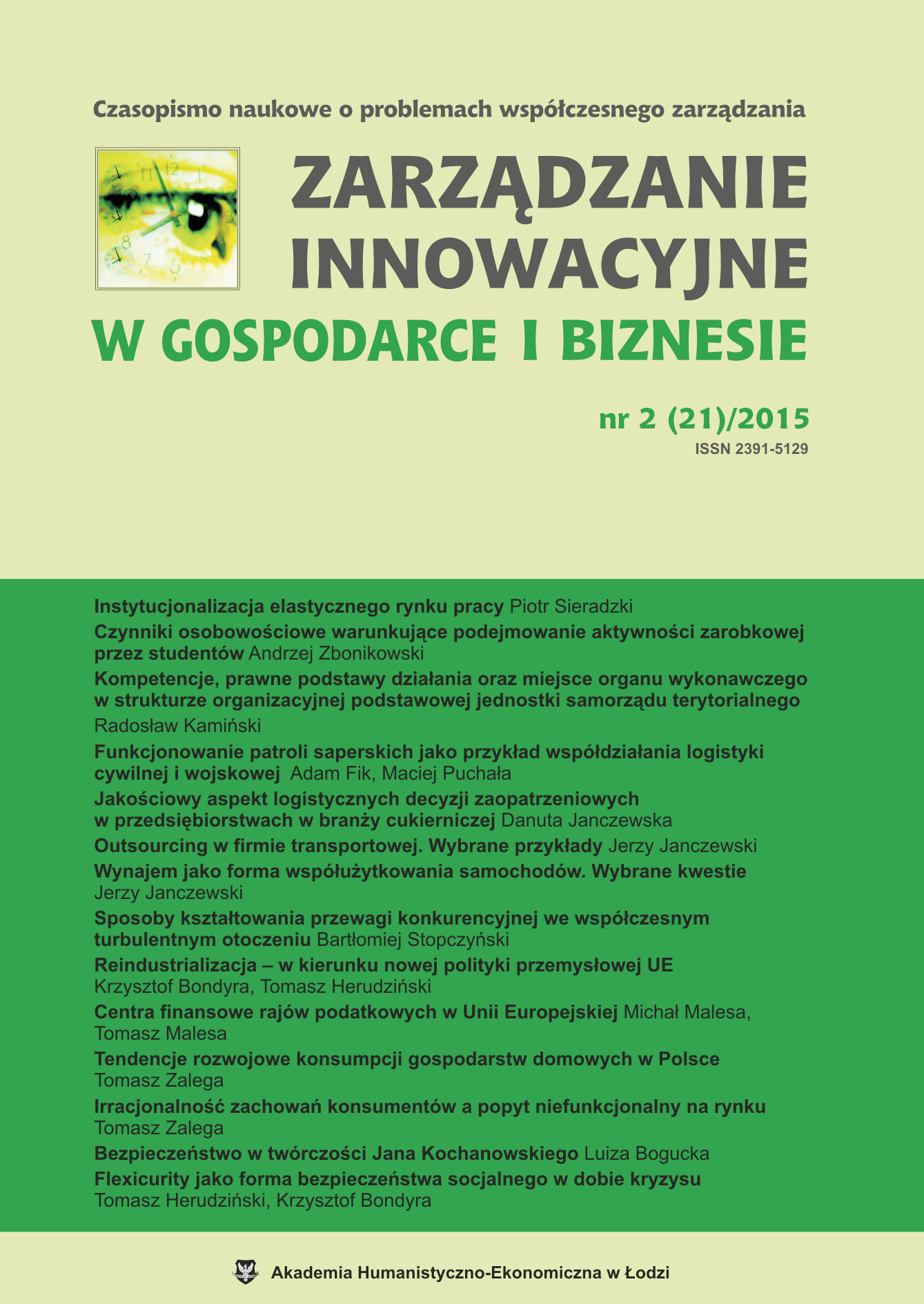Flexicurity as a form of social security in the current economic crisis
DOI:
https://doi.org/10.25312/Keywords:
flexicurity, welfare state, labour market, globalisation, economic crisisAbstract
The paper refers to the basic form of social security which is a work safety. The concept of flexicurity, which won particular popularity in Europe, is treated here as a tool of the welfare state subject to integration processes crossing national borders. Global processes such as the global economic crisis and demographic changes make it necessary to look for new security solutions on the labor market. Flexicurity is the answer to conflicting needs of society. Employers with an emphasis on competitiveness and social security of workers waiting. The high level of competitiveness is to provide flexibility understood as a smooth transition between different phases their careers. In particular: searching for their first job, job changes, assistance for the unemployed and the stage of retirement. Safety is treated here as a form employee’s position in the labor market which is achieved inter alia through lifelong learning to the employee. In the first part article focuses on the characteristics of the concept of flexicurity. Subsequently discussed the different models of f lexicurity. For example, Denmark and the Netherlands have been described two different ways to implement the idea of f lexicurity. Examples of German and Polish used to point to selected problems related to the implementation of ideas f exicurity.
Downloads
References
Barwińska-Małajowicz A. (2010), Wpływ modelu flexicurity na modernizację europejskich rynków pracy na przykładzie Polski i Niemiec, „Nierówności Społeczne a Wzrost Gospodarczy”, nr 17.
Bondyra K., Dolata D. (red.) (2012), Rzemieślnik – przyjazny pracodawca. Dobre praktyki w zakresie realizacji idei flexicurity, M-Druk Zakład Poligraficzno-Wydawniczy Janusz Muszyński, Poznań.
Czerwińska K. (2008), Flexicurity jako koncepcja polityki społecznej i zatrudnienia, „Polityka Społeczna”, nr 3.
Employment and Social Developments in Europe 2012 (2013), Komisja Europejska, Bruksela 8.01.2013, http://ec.europa.eu/social/main.jsp?catId=738&langId=pl&pubId=7315, dostęp: 6.09.2013.
Giddens A. (1999), Trzecia droga. Odnowa socjaldemokracji, Książka i Wiedza, Warszawa.
Houwing H., Schils T. (2008), From Policy to Practice. Assessing sectoral flexicurity in the Netherlands, Amsterdam, http://dare.uva.nl/document/357772, dostęp: 7.09.2013.
Komunikat Komisji Europa 2020. Strategia na rzecz inteligentnego i zrównoważonego rozwoju sprzyjającego włączeniu społecznemu (2010), Komisja Europejska, COM(2010) 2020 wersja ostateczna, Bruksela.
Krajowa Strategia Zatrudnienia na lata 2007–2013 (2005), Ministerstwo Pracy i Polityki Społecznej, http://www.funduszestrukturalne.gov.pl/informator/npr2/dokumenty%20strategiczne/ksz.pdf, dostęp: 7.08.2015.
Lang D. (2012), Duński model elastycznego bezpieczeństwa (flexicurity). Wzór do naśladowania?, http://rszarf.ips.uw.edu.pl/pdf/lang.pdf, dostęp: 23.08.2012.
Machol-Zajda L. (2003), Elastyczność czasu pracy w prawodawstwie krajów UE i Polski, „Zarządzanie Zasobami Ludzkimi”, nr 3–4.
Madsen P.K. (2002), The Danish Model of Flexicurity: A Paradise with some snakes, [w:] Labour market and social protection reforms in international perspective: Parallel or converging tracks?, Aldershot, Burlington.
Polski rynek finansowy w obliczu kryzysu finansowego w latach 2008–2009 (2010), Urząd Komisji Nadzoru Finansowego, Warszawa.
Rynek pracy w Polsce. Randstad: Nastroje się poprawiają (2013), http://msp.money.pl/wiadomosci/kadry/artykul/rynek;pracy;w;polsce;randstad;nastroje;sie;poprawiaja,97,0,1342817.html, dostęp: 7.09.2013.
Sikora T., Kuropatwa A. (2010), Hartz – sposób na bezrobotnych?, http://www.niemcy-online.pl/raporty/gospodarka/hartz-sposob-na-bezrobotnych-345, dostęp: 3.09.2013.
Sobolewski A. (2011), Elastyczne formy zatrudnienia. Katalog dobrych praktyk, Pomorska Akademia Kształcenia Zawodowego, Szczecin.
Sytuacja na rynku pracy w Polsce (2013), Departament Rynku Pracy MPiPS, Wydział Analiz i Statystyki (JMŁ), Warszawa.
Tomanek A. (2010), Flexicurity jako recepta na wyzwania współczesnego rynku pracy, Izba Rzemieślnicza i Przedsiębiorczości w Białymstoku, Białystok.
Downloads
Published
Issue
Section
License
Copyright (c) 2016 Akademia Humanistyczno-Ekonomiczna w Łodzi

This work is licensed under a Creative Commons Attribution-ShareAlike 4.0 International License.



